Electronic Monitoring Publication, England and Wales: 01 April 2021 to 31 March 2022
Published 26 May 2022
Main Points
This publication sets out statistics on electronic monitoring from 01 April 2021 to 31 March 2022.
| The number of individuals being actively monitored increased by 9% | At 31 March 2022, the total number of individuals actively monitored was 15,282, an increase from 13,996 as at 31 March 2021. |
| Electronic monitoring device court bail orders remains the largest cohort of individuals actively monitored by an electronic monitoring device | The number of individuals actively monitored under a court bail order was 5,662 as at 31 March 2022, or 37% of all individuals actively monitored. This is a 6% decrease from 6,001 as at 31 March 2021. |
| The number of individuals being actively monitored with a location monitoring device (GPS) has more than doubled | Between 31 March 2021 and 31 March 2022 the number of individuals actively monitored with a location monitoring device (GPS) increased by 138% (from 1,632 to 3,890). This increase is the result of expanding the use of electronic monitoring to new offender cohorts, particularly immigration bail. |
| The number of individuals being actively monitored with an alcohol monitoring device has increased | As at 31 March 2022, 900 individuals were actively monitored with an alcohol monitoring device, an increase from 36 as at 31 March 2021. This reflects the national roll-out of alcohol monitoring from March 2021. |
| 91% of electronically monitored offenders were male | As at 31 March 2022, 91% of electronically monitored offenders with bail, post release, or court sentences were male. This proportion has been broadly stable since 2015. |
| EMS performance improved in 2021/22 | EMS performance rose in 2021/22 relative to the previous year. All but one measure rose substantially (between 2 and 3pp), and five of the eight measures met their targets for the year, compared to three from the 2020/21 performance year. Performance improved the most in the last quarter of 2021/22 with seven out of eight measures rising relative to the previous quarter |
Statistician’s comment
Between 31 March 2021 and 31 March 2022, the number of individuals actively monitored increased. For most of the year the numbers of individuals actively monitored remained broadly stable, at around 14,000 people. From the middle of 2021/22 however the caseload began to increase, and has now reversed the decreasing trend seen between 2015 and 2020. This increase was driven by extensions to the use of location (GPS) monitoring tags for new offender cohorts, particularly it use for immigration bail, as well as the roll-out of alcohol monitoring tags.
This is the first time Electronic Monitoring statistics have been combined into one publication, and we would welcome any feedback as to the content and format of this release. Contact details can be found in the Further Information section.
Background
Electronic monitoring for compliance with curfews was introduced in 1999 to support the police, courts, prisons and wider justice system in England and Wales. It is a way of remotely monitoring and recording information on an individual’s whereabouts or movements and alcohol consumption, using an electronic tag which is normally fitted to a subject’s ankle. Information about the compliance with an individual’s order is monitored. Electronic monitoring may be used:
-
as a condition of court bail;
-
as a requirement of a court sentence, primarily community orders and suspended sentences;
-
for Home Detention Curfew
-
as a licence condition following release from custody;
-
as a condition of immigration bail, managed by the Home Office; and
-
to intensively monitor a small number of individuals including: some of the highest risk offenders managed under Multi-Agency Public Protection Arrangements (MAPPA); those granted bail by the Special Immigration Appeals Commission (SIAC); and those made subject to Terrorism Prevention and Investigation Measures (TPIMs).
The service to monitor curfews was expanded from November 2018 to introduce satellite enabled (GPS) location monitoring. GPS tags are now available to sentencers and decision makers as an option for court and post-custody cohorts. This is in addition to the use of GPS tags to monitor a small number of specialist cases. The tags use GPS technology to record an individual’s movements 24 hours a day. Roll-out was fully completed in March 2021 with the provision of GPS monitoring for under 18s.
GPS tags provide additional functionality, allowing the monitoring of:
-
Compliance with exclusion zones.
-
Attendance at a required activity or appointment.
-
An offender’s whereabouts (trail monitoring).
-
Multiple conditions or requirements if necessary, such as a combination of exclusion zones, curfew, monitored attendance and trail monitoring.
More recently HMPPS has expanded use of GPS tags to two offender cohorts:
-
Acquisitive crime: From April 2021 they have been used as a licence condition for adult offenders convicted of acquisition crime and who have served a prison sentence of 12 months or more. This is currently being piloted in 19 police forces.
-
Foreign National Offenders (FNOs): The Immigration Act 2016 introduced a duty on the Home Office Secretary of State to impose an electronic monitoring condition on FNOs granted immigration bail pending deportation. Following this, in August 2021, HMPPS began using GPS monitoring for these individuals who have been released from Prisons or Immigration Detention under ‘Immigration Bail’ on behalf of the Home Office.
Alcohol monitoring was introduced in October 2020 and went live throughout England and Wales on 31 March 2021 to support the new community sentencing option, the Alcohol Abstinence and Monitoring Requirement (AAMR). An AAMR may only be used when sentencing for alcohol-related criminal behaviour and it imposes a total ban on drinking alcohol for up to 120 days. Compliance with the ban is monitored electronically using an alcohol tag which continuously monitors for the presence of alcohol.
It may be imposed by the court as part of a Community Order or Suspended Sentence Order where:
-
The offence, or associated offence, for which the requirement is being imposed, is alcohol-related;
-
The subject is not alcohol dependent or has an Alcohol Treatment Requirement (ATR) recommended or in place; and
-
The subject is an adult i.e. 18 years or over
For offenders being released from custody whose offending and risk is alcohol related, an Alcohol Monitoring on Licence (AML) licence condition was introduced in Wales in 2021 and will be rolled out to England in June 2022. There are two conditions available for AML:
-
Requires total abstinence from alcohol, or
-
Requires the offender to comply with requirements specified by their supervising officer to address their alcohol needs, this will include limiting alcohol use.
Overall Summary
An individual may be given several orders at the same time and/or over the course of a year. Therefore there will be more active orders at any one time than there are people being monitored. If an individual has multiple orders, when looking at orders each will be counted separately, while when counting individuals the subject will be counted under the order type that started first.
At 31 March 2022, the total number of individuals actively monitored with an electronic monitoring device or alcohol monitoring device was 15,282, an increase of 9% compared with 31 March 2021. The first half of 2021/22 saw the number of individuals actively monitored remain broadly stable, but increased in the second half of the year.
Figure 1: Overall number of individuals with an Active Electronic Monitoring or Alcohol Monitoring Device, England and Wales, as at month-end, from April 2014 to March 2022 (Source: Table 1.4)
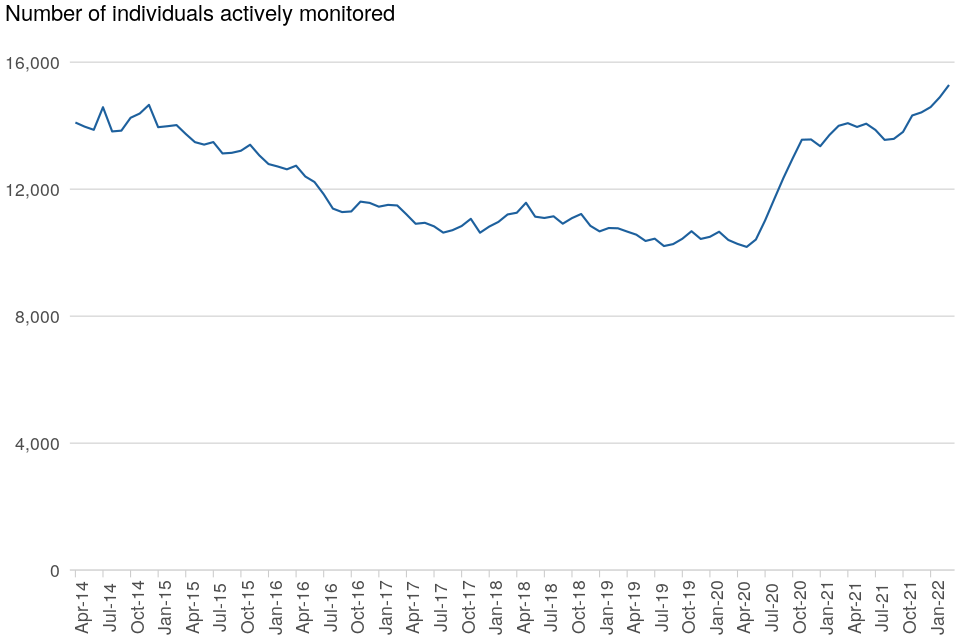
Electronic Monitoring Devices (Radio Frequency and GPS Tags)
Electronic monitoring devices are defined as radio frequency tags (used for home detention curfews) and location (GPS) tags, and exclude alcohol monitoring tags. As at 31 March 2022 the number of individuals actively monitored with an electronic monitoring device was 14,422, an increase of 3% compared to 31 March 2021. However, the electronic monitoring device caseload differs considerably by type of order in both absolute number and trend over time:
-
Court bail orders make up the largest proportion of electronic monitoring device orders for individuals on the caseload (39% of the caseload). At 31 March 2022, 5,662 individuals had court bail as their first order, down by 6% on the previous year.
-
Court sentences (community orders and suspended sentence orders) was the second largest group with 4,129 individuals (29% of the caseload), down by 18% on the same point in the previous year.
-
Post release was the third largest group with 3,144 individuals (22% of the caseload), rising by 22% when compared with the previous year.
-
Immigration order type increased, with 1,440 individuals (10% of the caseload).
-
Specials caseload made up a small part of the caseload and numbers have always been low since 2015.
The increases in the actively monitored post release and immigration cohorts contributed towards the increase in the overall caseload.
The number of new order notifications for the electronic monitoring device caseload decreased by 2% between the year ending 31 March 2021 and the year ending 31 March 2022. However, there was a 6% increase in the number of order completions. The increase in caseload along with the decrease in new notifications indicates orders, on average, lasting longer.
Figure 2: Individuals actively monitored by an electronic monitoring device, by Order Type (excluding Specials), England and Wales, as at month-end, from April 2014 to March 2022 (Source: Table 1.4)
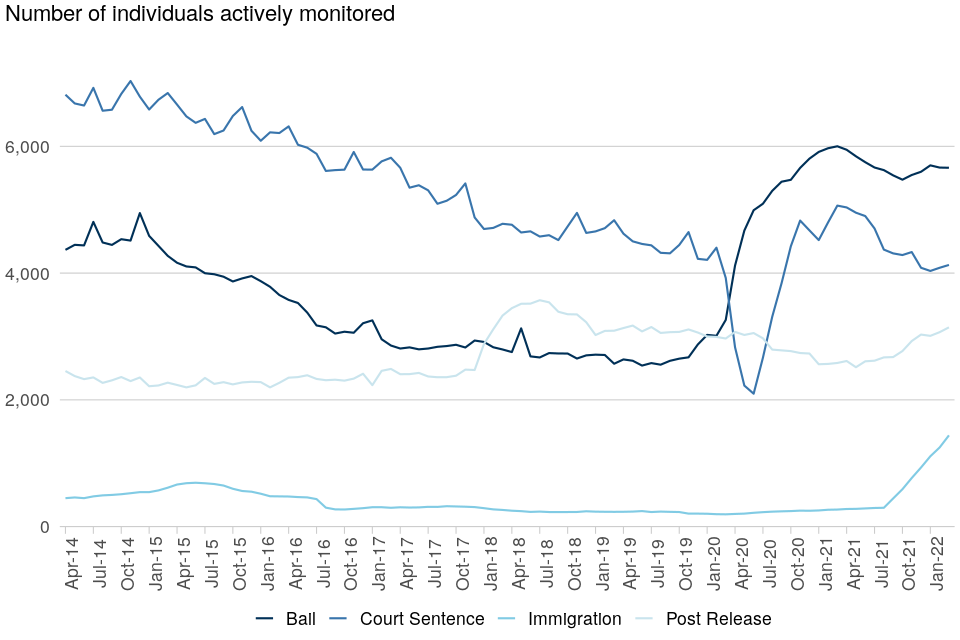
Location (GPS) Monitoring
Between March 2021 and March 2022 the number of individuals monitored using a GPS tag more than doubled, increasing from 1,632 people to 3,890. Over the same period the proportion of all monitored subjects (excluding those with an alcohol monitoring tag) that have a GPS tag increased from 12% to 27%. This increase in both the numbers and use of GPS tags is the result of expanding the use of electronic monitoring to new offender cohorts, particularly extending it to immigration bail. As at 31 March 2022 GPS immigration bail accounted for 37% of all individuals with a GPS tag.
Figure 3: Acquisitive Crimes Offenders and Foreign National Offenders, England and Wales, as at month-end, January 2019 to March 2022 (Source: Table 2.2)
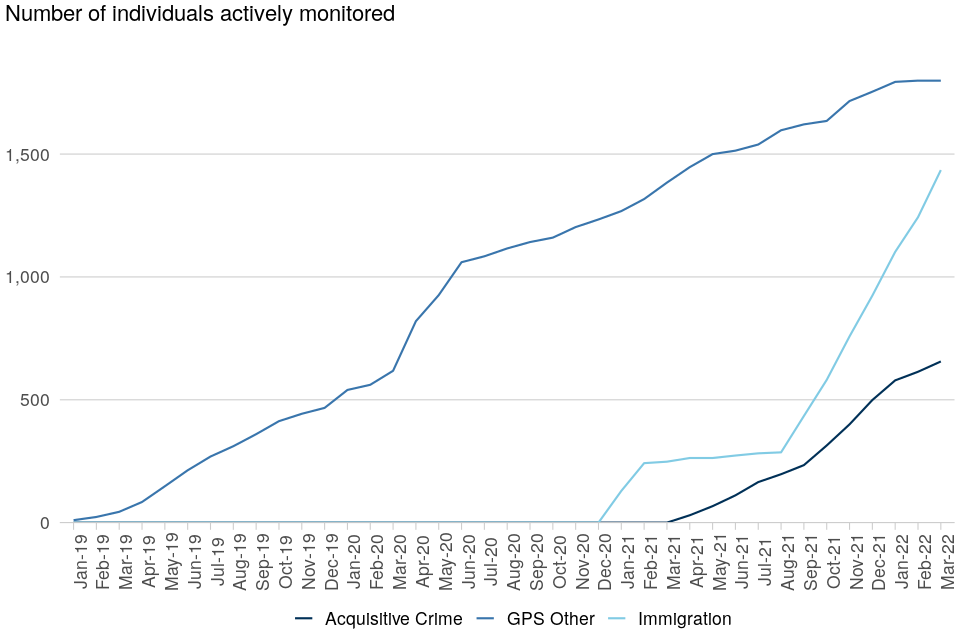
Alcohol Monitoring
There were 3,621 alcohol monitoring orders imposed across England and Wales in the year ending March 2022, a large increase from the 123 seen in the year ending March 2021. This primarily reflects the roll-out nationally of alcohol monitoring as a sentencing option. Correspondingly the number of individuals with an alcohol monitoring tag increased from 36 as at 31 March 2021 to 900 as at 31 March 2022.
At the end of March 2022, the compliance rate of those fitted with an alcohol tag was 97.2%. Compliance with alcohol monitoring is a cumulative measure, calculated as the total number of days in which the tag has not generated a tamper or alcohol alert divided by the total number of days the tag was fitted, since alcohol tags were introduced in October 2020.
Figure 4: Overall number of individuals with an Alcohol Monitoring Order, England and Wales, as at month-end, October 2020 to March 2022 (Source: Table 3.1)
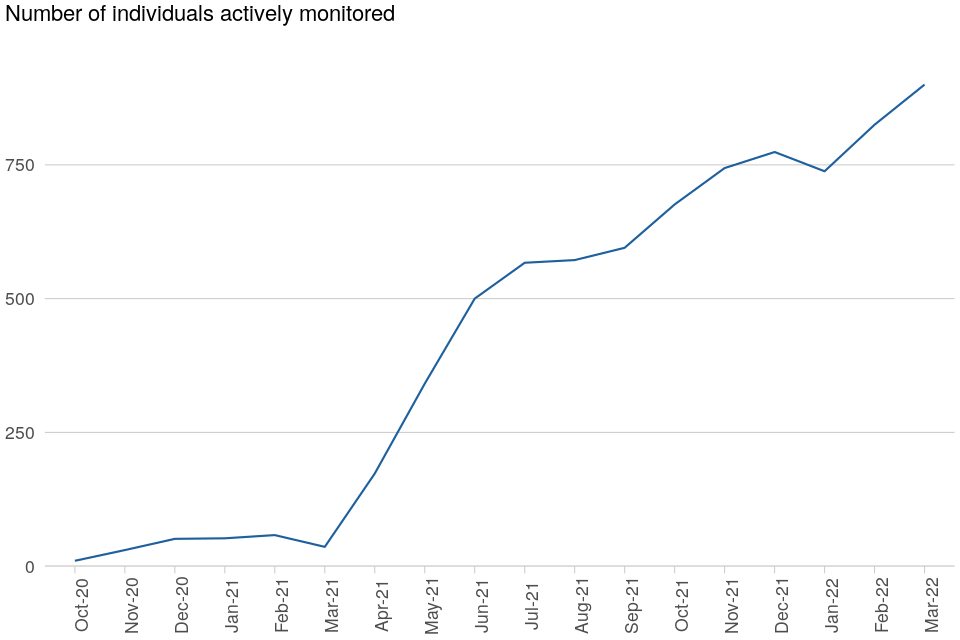
Equalities
At 31 March 2022, there were 12,935 monitored individuals who had Bail, Court Sentence or Post-Release electronic monitoring device orders. Of these:
-
91% were male and 9% were female;
-
30% were aged between 21-29, 30% were 30-39. 26% were aged 40 or over, 14% were under 21.
Looking at each order type individually, some differences emerge:
-
There are more bail individuals aged under 21 than the other cohort types included in this analysis, with 18% of the caseload in this group;
-
Of monitored females who had bail, court sentence, or post-release orders, 46% were in the court sentence caseload. The largest group for men was in the bail caseload, accounting for 44% of monitored males;
Figure 5: Percentage of electronically monitored individuals for Bail, Court Sentence and Post-Release orders by age group, England and Wales, as at 31 March 2022 (Source: Table 4.1)
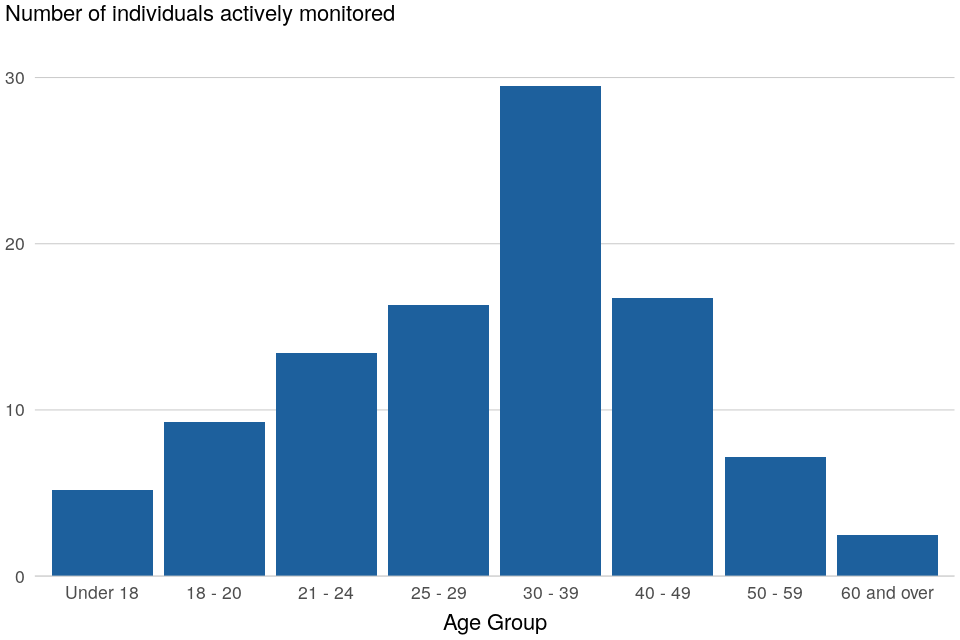
Contract Performance
The Electronic Monitoring Service (EMS), part of the Capita group, holds the contract for the provision of EM field and monitoring services, with the tags and hardware being managed through separate contracts with G4S and SCRAM systems, and with Airbus and Telefonica supporting the network delivery. SCRAM systems also provide alcohol monitoring software. Since March 2016 the delivery of the electronic monitoring service has been monitored against a national performance framework to make sure it is delivered in a timely and consistent manner. To note the figures presented exclude alcohol monitoring because this service was introduced after the performance framework was established.
EMS Performance was largely unchanged against each quarter. EMS performance was the highest in the final quarter of 2021-22, with seven out of eight measures rising relative to the previous quarter. Five out of the eight measures met their performance target. The poorest performing measure is SL 4C which is 2 percentage points below the target of 95% with 93% in the 2021/22 performance year to date.
More details on the service levels can be found in the technical report.
Figure 6: National EMS Performance of all available Service Levels for 21/22 Performance Year (01 April 2021 to 31 March 2022), England and Wales (Source: Tables 5.2, 5.3, 5.4, 5.5, 5.6, 5.7, 5.8 and 5.9)

Further information
Accompanying files
As well as this bulletin, the following products are published as part of this release:
-
Tables
-
Technical note
Data Quality
The statistics in this bulletin are classified as official statistics. The Statistics and Registration Service Act 2007 defines ‘official statistics’ as all those statistical outputs produced by the UK Statistics Authority’s executive office (the Office for National Statistics), by central Government departments and agencies, by the devolved administrations in Northern Ireland, Scotland and Wales, and by other Crown bodies (over 200 bodies in total). The statistics in this bulletin comply with all aspects of the Code of Practice for Official Statistics. The Code encourages and supports producers of statistics to maintain their independence and to ensure adequate resourcing for statistical production. It helps producers and users of statistics by setting out the necessary principles and practices to produce statistics that are trustworthy, high quality and of public value.
This publication has been produced to the high professional standards as set out in the Code of Practice for Statistics. However, the analysis is only as good as the data upon which it is based, and there is inherent uncertainty when the data is derived from diverse administrative data systems.
The addition of GPS monitoring devices and alcohol monitoring devices under the electronic monitoring expansion programme has created challenges with data recording on the contractors’ management information systems. As a result we have had to make a number of adjustments to the data to more accurately capture the numbers of actively monitored individuals in this release. These adjustments have involved manual manipulation of the datasets (please see the technical note for more details). While we are confident the trends presented are accurate, we plan to review the methodology used and put in place a more automated and systematic process for making these adjustments in time for the next release, which may result in some revisions to the figures.
For further details on the methodology used to compile the report, please refer to the technical note.
Future publications
Our statisticians regularly review the content of publications. Development of new and improved statistical outputs is usually dependent on reallocating existing resources. As part of our continual review and prioritisation, we welcome user feedback on existing outputs including content, breadth, frequency and methodology. Please send any comments you have on this publication including suggestions for further developments or reductions in content.
Contact
Press enquiries should be directed to the Ministry of Justice press office:
Tel: 020 3334 3536
Email: newsdesk@justice.gov.uk
Other enquiries about these statistics should be directed to Data and Analysis at the Ministry of Justice:
Julie Sullivan
HMPPS Electronic Monitoring Performance
Data and Analysis
Ministry of Justice
7th Floor
102 Petty France
London
SW1H 9AJ
Email: statistics.enquiries@justice.gov.uk
Next update: October 2022
© Crown copyright
Produced by the Ministry of Justice
Alternative formats are available on request from statistics.enquiries@justice.gov.uk
